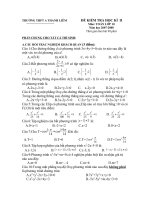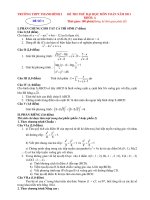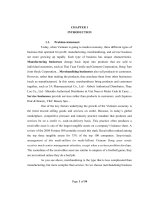Model writing task 2 8.5 8989 when a country develops its technology
Bạn đang xem bản rút gọn của tài liệu. Xem và tải ngay bản đầy đủ của tài liệu tại đây (212.82 KB, 9 trang )
Overall band score
8.5
8+9+8+9
See below C&C LR GRA
Model answer
WRITING TASK 2
You should spend about 40 minutes on this task.
Write about the following topic:
When a country develops its technology, the traditional skills and ways of life
die out. It is pointless to keep them alive.
To what extent do you agree or disagree with this opinion?
Give reasons for your answer and include any relevant examples from your own
knowledge or experience.
Write at least 250 words.
Original answer In an ever-progressing world, technological advancement is undoubtedly a driving
force, altering our conventional ways of life. This has led some to believe that this
evolution would completely obliterate traditional skills and lifestyles, rendering
their preservation futile. In this essay, however, I will challenge this school of
thought.
Granted, technological advances are somewhat posing a threat to traditional skills
and lifestyles. It is true that many age-old practices are being supplanted by more
efficient, technologically advanced methods. This can be seen in the diminished
demand for handwritten letters due to the instantaneousness of email and text
messaging. By the same token, the interest in manual agriculture has dwindled
drastically since the emergence of technologically enhanced farming methods like
precision farming and robotic weeding. Considering these factors, it seems futile
to go great lengths to preserve traditional skills and lifestyles in this day and age.
However, I am convinced that technology can play a role in preserving,
promoting, and even enhancing conventional practices, rather than completely
superseding them. This is evidenced by the revival of traditional textile crafts
through online platforms. Digital platforms host instructional videos, sell
handcrafted products globally, and encourage a new generation to learn these
age-old techniques. This example is a testament to the fact that technology can
coexist with tradition, instead of annihilating it.
It is also noteworthy that maintaining older skills and lifestyles is nowhere near a
futile effort. From a cultural standpoint, traditional practices form the bedrock of
a community’s identity and heritage, offering a sense of belonging and continuity
through generations. Economically, they can serve as a vital source of income,
particularly in regions that rely heavily on tourism. Bhutan perfectly exemplifies
this point. In this country, traditional crafts and ways of life have become a unique
selling proposition, attracting tourists globally and bolstering the economy. These
arguments underscore the cultural and economic benefits of protecting
traditional skills and lifestyles.
In conclusion, while technology can indeed lead to the marginalization of certain
traditional practices, it can also prove instrumental in their preservation and
promotion. Far from being pointless, keeping traditional skills and ways of life
alive is a valuable pursuit that offers cultural enrichment and economic benefits.
Overall band score
8.5
8+9+8+9
TR – Task Response nb – GRA and LR errors have not been corrected
Band score 8
You didn’t say much about lifestyles, despite mentioning them a few times. I’d
mention close-knit and extended families, which are becoming less common.
You have a clear position throughout and all parts of the question are addressed.
Your position is coherent and well-argued.
The ideas are relevant, extended and there are no contradictions.
Advice On Brainstorming For Task 2
As you’re planning and writing your answer, remember to constantly
ask yourself if you’re answering the question. Check back to the
question a few times as you think of ideas to make sure they're
directly relevant.
Make sure your introduction directly addresses the
question.
Make sure your ideas address all parts of the question. If
the question asks for solutions, in the plural, you must
suggest at least 2.
Make sure your main ideas, as stated in the first sentence
of the main body paragraphs, are directly relevant to the
question.
Make sure your supporting ideas, which follow the main
ideas in the main body paragraphs, directly support the
main idea.
Make sure your supporting ideas are developed, which
means there should be more information in the form of
evidence, reasons, and/or examples.
Very often, the optimum number of supporting ideas is 2.
This allows you to develop your ideas and your less likely
to have isolated, unsupported ideas that could get you a 6
for TR. “some may be undeveloped/unclear” – band score
6 TR.
Be especially careful if you’ve answered similar question
before, as there will always be important differences.
Make sure your conclusion directly answers the question,
that it is consistent with the ideas in the main bodies, and
that it does not contradict the introduction.
In an ever-progressing world, technological advancement is undoubtedly a driving
force, altering our conventional ways of life. This has led some to believe that this
evolution would completely obliterate traditional skills and lifestyles, rendering
their preservation futile. In this essay, however, I will challenge this school of
thought. [a]
Granted, technological advances are somewhat posing a threat to traditional skills
and lifestyles[b]. It is true that many age-old practices are being supplanted by
more efficient, technologically advanced methods. This can be seen in the
diminished demand for handwritten letters due to the instantaneousness of email
and text messaging. By the same token, the interest in manual agriculture has
dwindled drastically since the emergence of technologically enhanced farming
methods like precision farming and robotic weeding. Considering these factors, it
seems futile to go great lengths to preserve traditional skills and lifestyles in this
day and age. [c]
However, I am convinced that technology can play a role in preserving,
promoting, and even enhancing conventional practices, rather than completely
superseding them[d]. This is evidenced by the revival of traditional textile crafts
through online platforms. Digital platforms host instructional videos, sell
handcrafted products globally, and encourage a new generation to learn these
age-old techniques. This example is a testament to the fact that technology can
coexist with tradition, instead of annihilating it. [e]
It is also noteworthy that maintaining older skills and lifestyles is nowhere near a
futile effort[f]. From a cultural standpoint, traditional practices form the bedrock of
a community’s identity and heritage, offering a sense of belonging and continuity
through generations. Economically, they can serve as a vital source of income,
particularly in regions that rely heavily on tourism. Bhutan perfectly exemplifies
this point. In this country, traditional crafts and ways of life have become a unique
selling proposition, attracting tourists globally and bolstering the economy. These
arguments underscore the cultural and economic benefits of protecting
traditional skills and lifestyles. [g][h]
In conclusion, while technology can indeed lead to the marginalization [i]of certain
traditional practices, it can also prove instrumental in their preservation and
promotion. Far from being pointless, keeping traditional skills and ways of life
alive is a valuable pursuit that offers cultural enrichment and economic benefits.
[j]
C&C - Cohesion and Coherence nb GRA and LR errors have not been corrected
Band score 9
Excellent cohesion and coherence throughout, with no errors.
The sentences have a natural flow characteristic of high band score answers.
In an ever-progressing world, technological advancement is undoubtedly a driving
force, altering our conventional ways of life. This has led some to believe that this
evolution would completely obliterate traditional skills and lifestyles, rendering
their preservation futile. In this essay, however, I will challenge this school of
thought.
Granted, technological advances are somewhat posing a threat [k]to traditional
skills and lifestyles[l]. It is true that many age-old practices are being supplanted by
more efficient, technologically advanced methods. This can be seen in the
diminished demand for handwritten letters due to the instantaneousness of email
and text messaging. By the same token, the interest in manual agriculture has
dwindled drastically since the emergence of technologically enhanced farming
methods like precision farming and robotic weeding. Considering these factors, it
seems futile [m]to go great lengths to preserve traditional skills and lifestyles in this
day and age.
However, I am convinced that technology can play a role in preserving,
promoting, and even enhancing conventional practices, rather than completely
superseding them[n]. This is evidenced [o]by the revival of traditional textile crafts
through online platforms. Digital platforms host instructional videos, sell
handcrafted products globally, and encourage a new generation to learn these
age-old techniques. This example is a testament to the fact that technology can
coexist with tradition, instead of annihilating it.
It is also noteworthy that maintaining older skills and lifestyles is nowhere near
a futile effort[p]. From a cultural standpoint, traditional practices form the bedrock
of a community’s identity and heritage, offering a sense of belonging and
continuity through generations. Economically, they can serve as a vital source of
income, particularly in regions that rely heavily on tourism. Bhutan perfectly
exemplifies this point. In this country, traditional crafts and ways of life have
become a unique selling proposition, attracting tourists globally and bolstering
the economy. These arguments underscore the cultural and economic benefits of
protecting traditional skills and lifestyles.
In conclusion, while technology can indeed lead to the marginalization of certain
traditional practices, it can also prove instrumental in their preservation and
promotion. Far from being pointless, keeping traditional skills and ways of life
alive is a valuable pursuit that offers cultural enrichment and economic benefits.
LR- - Lexical resource nb Some GRA errors have not been corrected
Band score 8
Vocabulary is used accurately with sufficient flexibility to show precise meaning,
and with only minor inaccuracies, which is good for a band score 8
In an ever-progressing world, technological advancement [q]is undoubtedly a
driving force, altering our conventional ways of life. This has led some to believe
that this evolution [r]would completely obliterate [s]traditional skills and lifestyles,
rendering their preservation futile. In this essay, however, I will challenge this
school of thought.
Granted, technological advances are somewhat posing a threat [t]to traditional
skills and lifestyles. It is true that many age-old practices are being supplanted by
more efficient, technologically advanced methods. This can be seen in the
diminished demand for handwritten letters due to the instantaneousness[u] of
email and text messaging. By the same token, the interest in manual [v]agriculture
has dwindled drastically since the emergence of technologically enhanced farming
methods like precision farming and robotic weeding. Considering these factors, it
seems futile to go great lengths to preserve traditional skills and lifestyles in this
day and age.
However, I am convinced that technology can play a role in preserving,
promoting, and even enhancing conventional practices, rather than completely
superseding them. This is evidenced by the revival of traditional textile crafts
through online platforms. Digital platforms host instructional videos,
sell handcrafted products globally, and encourage a new generation to learn
these age-old techniques. This example is a testament to the fact that technology
can coexist with tradition, instead of annihilating it[w].
It is also noteworthy that maintaining older skills and lifestyles is nowhere near a
futile effort. From a cultural standpoint, traditional practices form the bedrock of
a community’s identity and heritage, offering a sense of belonging and continuity
through generations. Economically, they can serve as a vital source of income,
particularly in regions that rely heavily on tourism. Bhutan perfectly exemplifies
this point. In this country, traditional crafts and ways of life have become a unique
selling proposition[x], attracting tourists globally [y]and bolstering the economy.
These arguments underscore the cultural and economic benefits of protecting
traditional skills and lifestyles.
In conclusion, while technology can indeed lead to the marginalization of certain
traditional practices, it can also prove instrumental in their preservation and
promotion. Far from being pointless, keeping traditional skills and ways of life
alive is a valuable pursuit that offers cultural enrichment and economic benefits.
GRA - Grammatical range and accuracy nb Some LR errors have not been
corrected
Band score 9
Grammar is used accurately in a wide variety of structures, which should be good
for a band score 9.
Punctuation is used correctly throughout.
Appropriate structures are used throughout.
In an ever-progressing world, technological advancement is undoubtedly a driving
force, altering our conventional ways of life. This has led some to believe that this
evolution would completely obliterate traditional skills and lifestyles, rendering
their preservation futile. In this essay, however, I will challenge this school of
thought.
Granted, technological advances are somewhat posing a threat to traditional skills
and lifestyles. It is true that many age-old practices are being supplanted by more
efficient, technologically advanced methods. This can be seen in the diminished
demand for handwritten letters due to the instantaneousness of email and text
messaging. By the same token, the interest in manual agriculture has dwindled
drastically since the emergence of technologically enhanced farming methods like
precision farming and robotic weeding. Considering these factors, it seems futile
to go great lengths to preserve traditional skills and lifestyles in this day and age.
However, I am convinced that technology can play a role in preserving,
promoting, and even enhancing conventional practices, rather than completely
superseding them. This is evidenced by the revival of traditional textile crafts
through online platforms. Digital platforms host instructional videos, sell
handcrafted products globally, and encourage a new generation to learn these
age-old techniques. This example is a testament to the fact that technology can
coexist with tradition, instead of annihilating it.
It is also noteworthy that maintaining older skills and lifestyles is nowhere near a
futile effort. From a cultural standpoint, traditional practices form the bedrock of
a community’s identity and heritage, offering a sense of belonging and continuity
through generations. Economically, they can serve as a vital source of income,
particularly in regions that rely heavily on tourism. Bhutan perfectly exemplifies
this point. In this country, traditional crafts and ways of life have become a unique
selling proposition, attracting tourists globally and bolstering the economy. These
arguments underscore the cultural and economic benefits of protecting
traditional skills and lifestyles.
In conclusion, while technology can indeed lead to the marginalization of certain
traditional practices, it can also prove instrumental in their preservation and
promotion. Far from being pointless, keeping traditional skills and ways of life
alive is a valuable pursuit that offers cultural enrichment and economic benefits.









